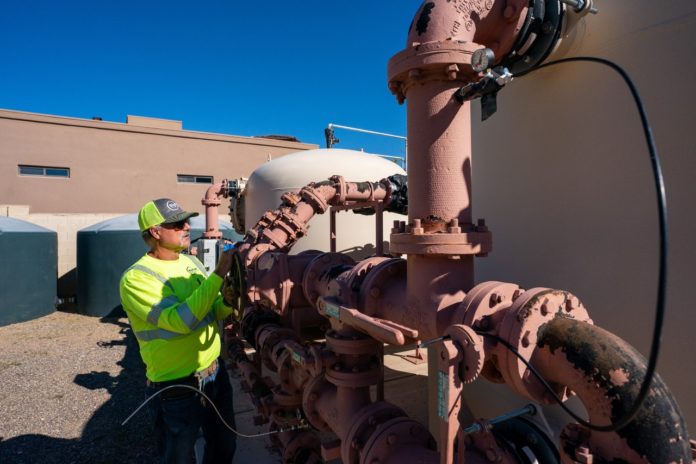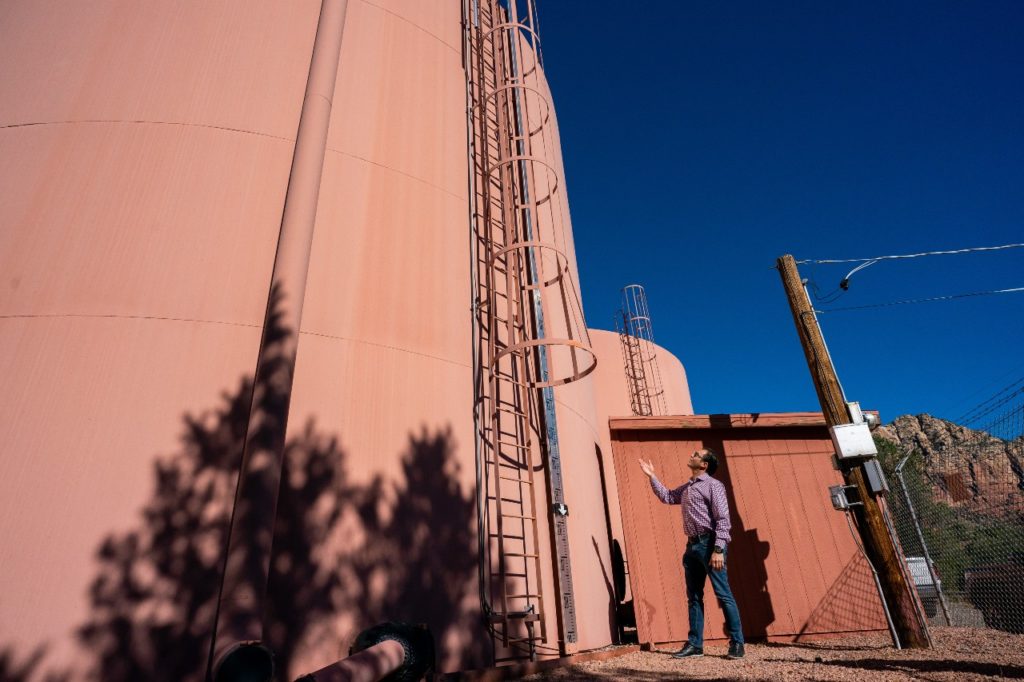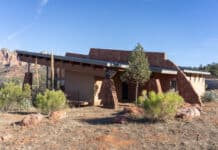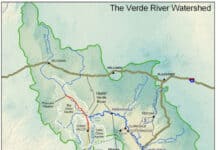
Last August, the U.S. Bureau of Reclamation declared a Tier 1 water shortage on the Colorado River — the first time a shortage has been declared since a water-sharing agreement was ratified by seven Western states in 1944. The declaration triggers an 18% reduction in Arizona’s allocation of Colorado River water, or 166 billion gallons per year, beginning in 2022.
Given the cuts, and the possibility of more if long-term drought continues, many local residents have wondered how the Verde Valley will be affected.
The short answer is that the Verde Valley and the Village of Oak Creek will not be directly affected by the Colorado River cuts because the region doesn’t receive any Colorado River water. Nor is the Verde Valley currently part of an Active Management Area, a region with groundwater managed under the 1980 Arizona Groundwater Code.
However, long-term drought and unrestricted groundwater pumping could affect the level of groundwater stored in the Supai rock formation beneath the VOC, where virtually all of the local water supplies come from.
According to Max Wilson, a program manager with Friends of the Verde River, drops in the aquifer level can have serious consequences. He said a lower water table can reduce the flow of surface water from springs and streams, and drops can also increase the costs of water, as well owners have to drill deeper to find water.
“Small drops in the water table seem unimportant,” Wilson wrote in an email, “unless they bring the water table below the depth of your well and you are faced with the choice of paying to haul water or spending tens of thousands of dollars on drilling deeper. Over the long-term, declining groundwater levels will impact us all unless we find ways to work together and use water more sustainably.”
The Supai Formation
Big Park Water Co. operates five active wells throughout the VOC and serves 3,200 customers, including the hotels, according to Nick Gudovic, operations manager for Big Park.
Gudovic expressed a sense of wonder for the local aquifer, recalling how workers can sometimes hear the water flowing through caverns and chambers 400 feet below the ground during seasonal movements of water, usually in the spring, and after big weather events.
He said the local aquifer is part of a geologic formation that runs from Mingus Mountain to the Grand Canyon. He noted that a recent U.S. Geological Survey estimated that local groundwater pumped today likely fell as snow on the mountains north of the VOC 8 to 30 years ago, before filtering through limestone into the aquifer.
“It’s a whole ecosystem,” Gudovic said of the precipitation to groundwater cycle.
Gudovic said the local groundwater has naturally occurring arsenic, so all of the company’s wells in the VOC have passive treatments using titanium to remove the arsenic, but nothing else is removed or added to the water.
“There’s 30 years of natural filtration occurring,” he said.
Drought Impacts
“We’re business as normal,” Gudovic said of the local impacts of the declared water shortage on the Colorado River. “We don’t identify any long-term impacts with our water availability.”
Gudovic delivered the same message last month at a special meeting of the Arizona Corporation Commission, which requested that the three largest classes of private water companies in the state give a status report on their readiness to ensure sufficient water supply in the face of drought and mandatory cuts to Colorado River water next year. The ACC doesn’t regulate water systems owned by municipalities, such as Cottonwood’s system.
In a letter to the board, Gudovic wrote, “We do not see any major customer growth that would affect our water supplies.”
In one sense, there’s plenty of water in the local aquifer. Gudovic said his wells go down to 800 feet, and the aquifer is currently at 400 feet. The Supai formation holds an enormous quantity of water, and below the Supai, there’s another water-holding formation, the Redwall, which is “even larger,” he said.
But as noted earlier, a lowered aquifer can have negative effects, even if it doesn’t pose an existential threat to water availability.
“It is difficult to say exactly how much of the aquifer has been developed to date because the Verde River is supported by multiple aquifers and monitoring is poor,” Wilson said.

Gudovic agrees that it’s difficult to assess what is happening to the aquifer level at any given moment. Big Park Water monitors the water level quarterly, and Gudovic said the aquifer rises and falls seasonally as well as over multiple year cycles, based on long-term precipitation trends, making it difficult to judge the impact of pumping on the aquifer.
He suspects that the aquifer level has dropped since it was first developed — somewhere in the single digits of feet, he guessed — but not at a rate that gives him cause for concern.
“I would say we’re trending in a good direction,” Gudovic said. “We actually see a decreasing usage per customer over time …. People are switching to low-flow fixtures.”
“The largest threat to our water systems in the Verde Valley is that groundwater pumping is essentially unregulated,” Wilson said. “This means that any landowner can drill a new well and pump as much as they like, even if this dries up existing wells or if it dries up our rivers and creeks. People all over rural Arizona are already seeing their wells dry up, and one of the headwaters springs of the Verde, Del Rio, has nearly stopped flowing.”
Golf
Golf is a major consumer of water in the VOC. The three courses in the VOC combined use an average of 1.13 million gallons of water per day. All three courses, Oakcreek Country Club, Canyon Mesa Country Club and Sedona Golf Resort, pump water from wells they own.
To put the golf water usage in perspective, Gudovic said all Big Park Water Co. customers use about 600,000 gallons per day during the winter, a time of lower residential water usage. That is roughly the average daily use for the OCC course.
One course, OCC, takes all of the available treated effluent water from the Big Park Domestic Wastewater Improvement District to water its course. The effluent supplies 30% to 40% of OCC’s water needs, according to Robert Walton, the superintendent of OCC. The district currently does not produce enough treated effluent to supply any other courses.
Thirsty Turf at Golf Courses Golf Courses are major water users in Sedona and the Village of Oak Creek. All of the golf courses operate their own wells and pump groundwater directly from the aquifer, except Poco Diablo, which uses surface water. Two courses, Oakcreek Country Club and Seven Canyons, use treated effluent for part of their water needs. About 30% to 40% of OCC’s water comes from effluent. The following information comes from the Arizona Water Atlas using data collected in 2008. Courses Holes Gallons/day Canyon Mesa Golf Course 9 100,879 Oakcreek Country Club 18 625,812 Poco Diablo Golf Course 9 30,353 Sedona Golf Resort 18 407,090 Seven Canyons Golf Club 18 377,630
The BPDWID sewer system consists of approximately 27 miles of sewer lines with five lift stations, according to its website. Last year the system was expanded to Fairway Oaks Drive from Bell Rock Boulevard to the end of the street before the road turns north, the entire length of Chaparral Drive, north on Sugar Loaf to Manzanita and north on Arch Drive for 250 feet.
Golf courses in the Phoenix metropolitan area and other parts of the state in Active Management Areas were facing proposed mandatory cuts to water use earlier this year. One proposal by the Arizona Department of Water Resources called for a 3% cut for courses in AMAs, which was resisted by industry leaders. Local golf courses would not have been affected by the proposal since the local groundwater is not regulated.
Wilson would like to see local groundwater get greater protections.
According to Chris Kuzdas, a water program manager with the Environmental Defence Fund, “There is also a significant state-level discussion happening about a new concept called ‘Rural Management Areas.’”
An EDF document states that “RMAs were proposed under [Arizona House Bill] 2679 introduced in 2021, which would permit county Boards of Supervisors to create an RMA for specific groundwater basins or sub-basins at risk. Counties could opt into this program and thus authorize creation of local plans to manage, protect and conserve groundwater in regions outside existing AMAs.”





















